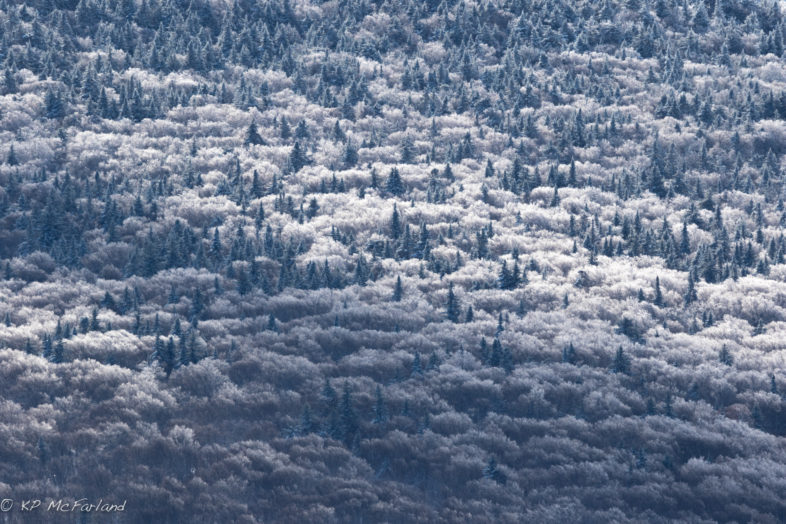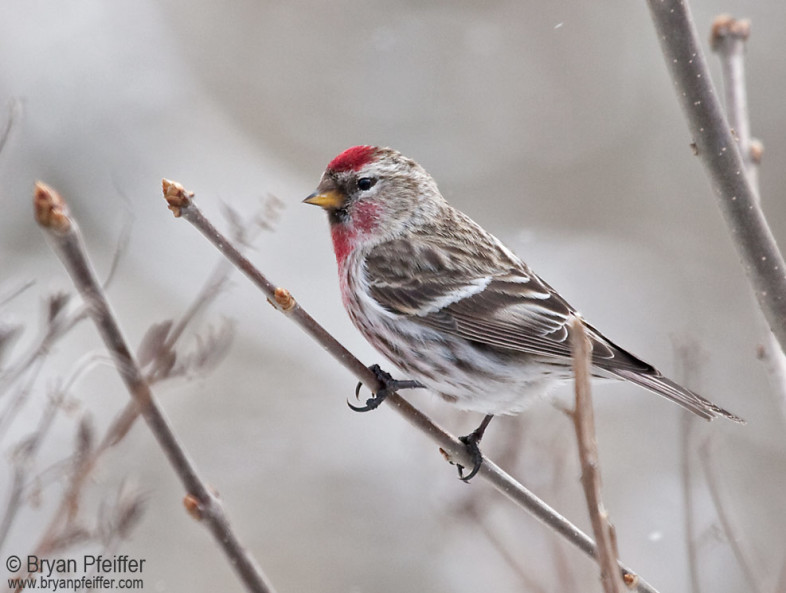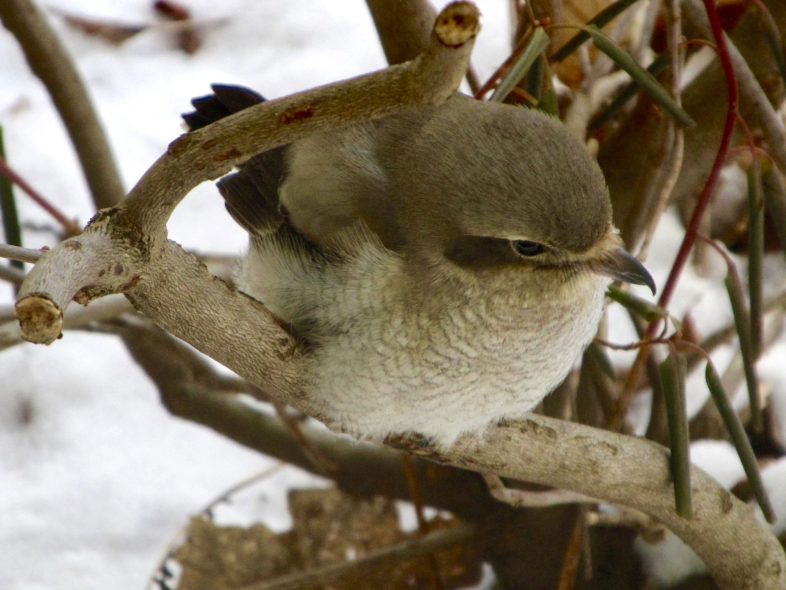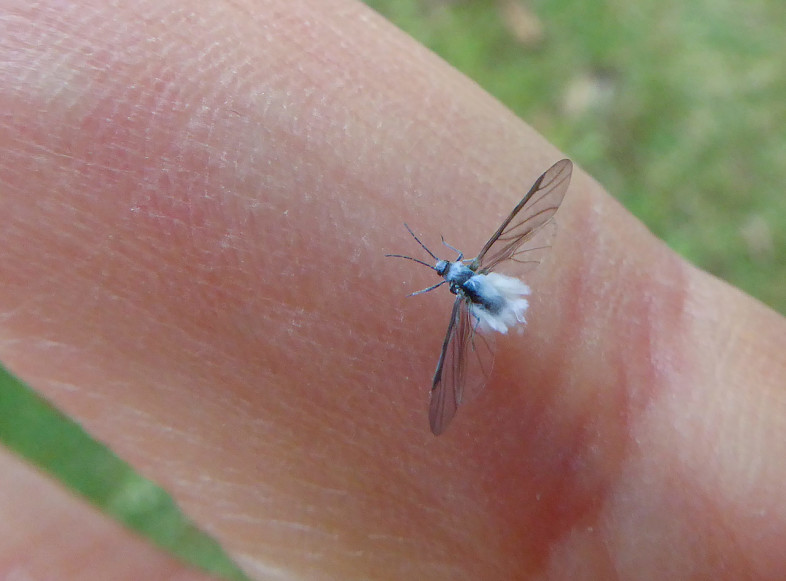“Stick Season,” as we call it here in New England, when the woods are gray and cold, is anything but lifeless. Fall migration continues with passing waterfowl and the final hawks drifting south. The year’s last butterflies remain on the wing. And winter visitors – like Common Redpolls – will be arriving in good numbers – we hope. Learn more in our Field Guide to November.
Redpoll Invasion
The redpolls are coming! They redpolls are coming! Common Redpolls are one of those species that are considered to have irruptions, an often dramatic and irregular migration of large numbers of birds (or other migratory species like the irruption of Painted Lady butterflies we just had) to areas away from their normal range. Scientists think that these finch irruptions are caused by shortages in conifer and birch seeds in the far north. Many are predicting that this year will be a great year for Redpolls and other northern seedeaters here in the Northeast as seeds are scarce in the north. It use to be that Redpoll irruptions southward into the Northeast happened biennially and one could predict this with great accuracy. But about a dozen years ago, that cycle seems to have gone a bit haywire, possibly because the regular cycle of seeds has too.
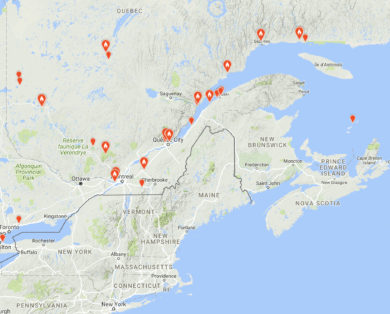
A map of Common Redpoll sightings reported to eBird in October 2017. Visit the map and see if they’ve moved closer to you.
A good crop of seeds in the winter for finches is the difference between life and death. To cope with the extreme cold, finches ramp up their metabolic rate and put on 50 percent more fat in the winter. They can also store seed in throat pouches to eat later. Redpolls sometimes tunnel into the snow to spend the night under an insulated blanket of snow.
The redpolls have yet to arrive, but you can keep an eye on their progress on the live map from Vermont eBird and add your sightings too.
There may be more northern birds to come. Cone crops in the Northeast are bumper this year, perhaps the best crop in a decade or more. This will likely be a banner winter to see other boreal finches such as Red and White-winged crossbills, Pine Siskins, and Purple Finches.
And the Butterflies Flew No More
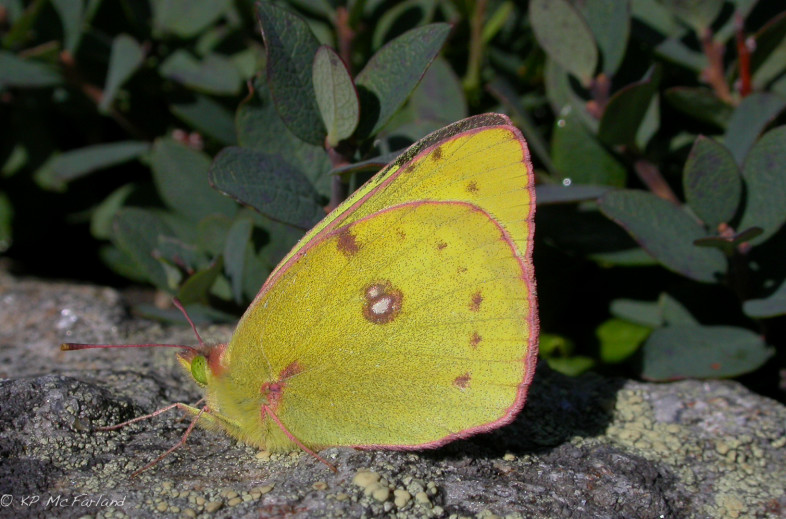
Clouded Sulphur (Colias philodice) takes a break in the high peaks of the Presidential Range, NH. / © K.P. McFarland
November may be known for its gray skies and brown landscapes here in the Northeast, but there are always a few glorious blue days with temperatures rising into the short-sleeve zone. And with those days come the last of the fluttering butterflies. You can find a few Clouded and Orange Sulphurs dancing about the fields. Maybe you’ll run into a camouflaged anglewing — Question Marks and Eastern Commas — adding punctuation to your fine day outdoors. And the truth is, during many Novembers, you might now have a better chance finding them. On average, butterfly flight periods are likely lengthening.
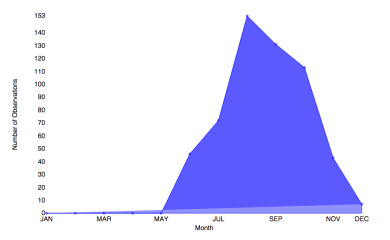
Clouded Sulphur flight season in Vermont from e-Butterfly.org data. Some are found in the Champlain Valley as late as early December.
A study in Canada showed that the timing of butterfly flight seasons responded to temperature both across the landscape (variation in average temperature from site to site in Canada) and across time (variation from year to year within each individual site). They found that given the widespread temperature sensitivity of flight season timing, with increased warming we can expect long-term temporal shifts of 2.4 days for every 1.8 degree F change in air temperature for many if not most butterfly species.
Help us document the late season fliers!
When you find a November (or even December!) butterfly, snap a photograph and submit it to e-Butterfly.org, a project of the Vermont Atlas of Life. Let’s see who can find the latest butterfly in 2017!
Wingless Moth flying near you
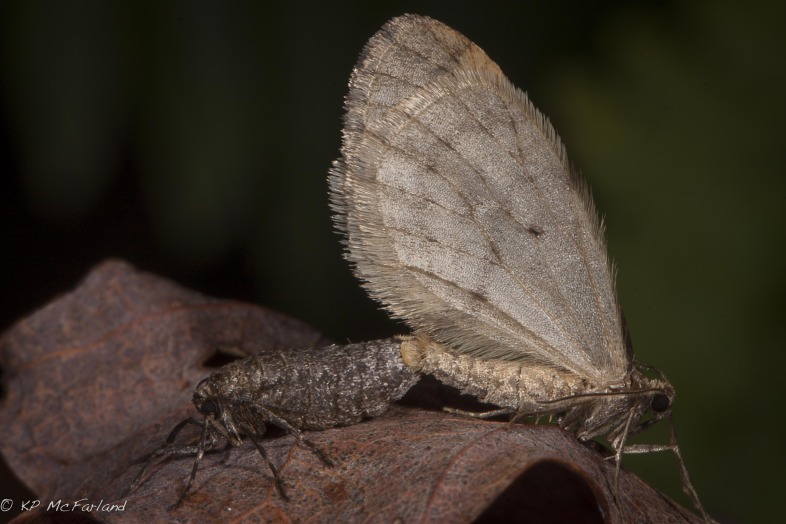
Bruce Spanworm (Operophtera bruceata) is one of the inchworms, a member of the large moth family called Geometridae (which means “earth-measuring”). / © K.P. McFarland
November at dusk with the temperature barely breaking 40 degrees I could see my breath. Yet, all around me moths fluttered through the woods. They were one of two species in the genus Operophtera, visually drab, but physically magical.
Whether these were the native Bruce Spanworm (O. bruceata) or the introduced Winter Moth (O. brumata), devilishly hard to identify by photograph alone, I couldn’t discern (but O. brumata is farther south so far). Either way, both of these small, cold weather moths are thermo-conformers. Incredibly, they can fly with air and body temperature ranging from just 27 Fahrenheit up to a balmy 77 degrees Fahrenheit.
Flight is energetically costly, requiring warm, powerful muscles that can create enough wing strokes to stay airborne. How do these tiny moths fly in such cold conditions when muscles simply don’t operate very quickly? Morphology appears to be the key.
The male Bruce Spanworm has one of the lowest wing-loads (total weight divided by wing area) of any moth measured. This reduces the frequency of wing beats necessary to sustain flight and lowers the energetic cost. They also have one of the highest flight muscle to body size ratios. These bulky muscles are able to compensate for low contraction velocity in the cold with a high capacity to generate tension. Strong muscles, combined with fewer necessary wing beats allow them to operate in very low temperatures as they seek the scent of females wafting pheromones.
The female is also well adapted to low autumn temperatures. They are flightless. The Bruce Spanworm has no wings at all while the Winter Moth has just the vestiges of wings on its back visible. When they emerge in October or November, they crawl to the lower trunk of a host tree where they solicit flying males with fine chemistry.
Without bulky flight muscles weighing them down, Bruce Spanworm females fill their body from the edge of the thorax to the tip of the abdomen with eggs, 143 on average. That’s over 60% of their total body weight. A flight model by James Marden, a biologist at Penn State, suggested that if a female were to fly again with even weak flight at optimal temperatures, they would have a 17% reduction in the number of eggs they could carry. The female moth would experience an 82% reduction in fecundity to fly powerfully.
Flying and crawling in the cold was likely a great adaptation to a powerful natural selection force, predation. By late October a large percentage of insectivorous birds have migrated south and bats have migrated or hibernated for the winter. With fewer predators comes great success. Submit your sightings to iNaturalist Vermont , a project of the Vermont Atlas of Life.
The Last adult Dragonfly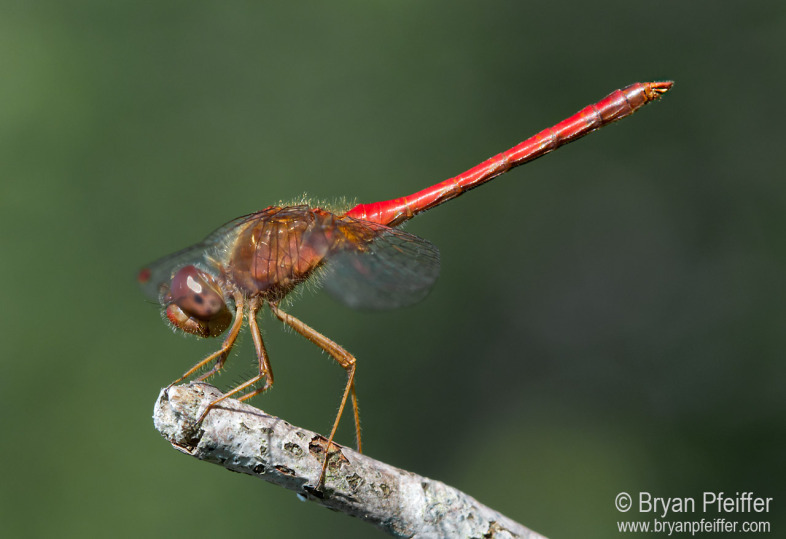
We don’t call it Autumn Meadowhawk for nothing. Find it this autumn in your local meadow hawking for insects. One of 144 dragonfly and damselfly species in Vermont, this one begins its flight season in July. Our latest flight date on record is November 26. Vermont has six of these red meadowhawk species (in the genus Sympetrum), only one of which, this one, has yellow legs and most likely the last adult dragonfly you’ll see until April (unless you head south this winter). Look for it drifting past fall hawkwatch sites or baking in what little sun and warmth is available in various open habitats late in the year. Submit your sightings to iNaturalist Vermont to add your data to the Vermont Damselfly and Dragonfly Atlas, a project of the Vermont Atlas of Life.
The Butcher Bird Calls
No, not the turkey on your platter. We’re talking about Northern Shrikes, aka “butcher bird” – a predatory songbird that breeds in the far north and winters in southern Canada and the northern United States. Shrikes feed on small birds, mammals, and insects, and are known for impaling them on spines trees or barbed wire fences. Chris Rimmer and Chip Darmstadt discovered that they can return winter after winter to the same territory. Using band recoveries, they found 12 cases in which shrikes were recaptured at or near the same winter location one to three years later. You can see if there are any reported near you on Vermont eBird. Keep a lookout for these feisty songbirds and be sure to report your sightings to Vermont eBird, a project of the Vermont Atlas of Life.
Lint alerT: “Blue Fuzzy-Butts” flying near you
Those tiny tufts of powder-blue lint floating, well, like floaters in your field of view, aren’t outcasts from the dryer cycle. They’re hearty November insects, the adult form of a wooly aphid species. We more often see these aphids gathered in a mass on speckled alder, sucking liquids and covered with a waxy white coating resembling cotton or wool (like the image here). But the adult stage (the blue-lint form) is now on the wing. Bryan’s partner Ruth calls them “Blue Fuzzy-Butts.” Bryan reports on his blog.
getting sleepy?
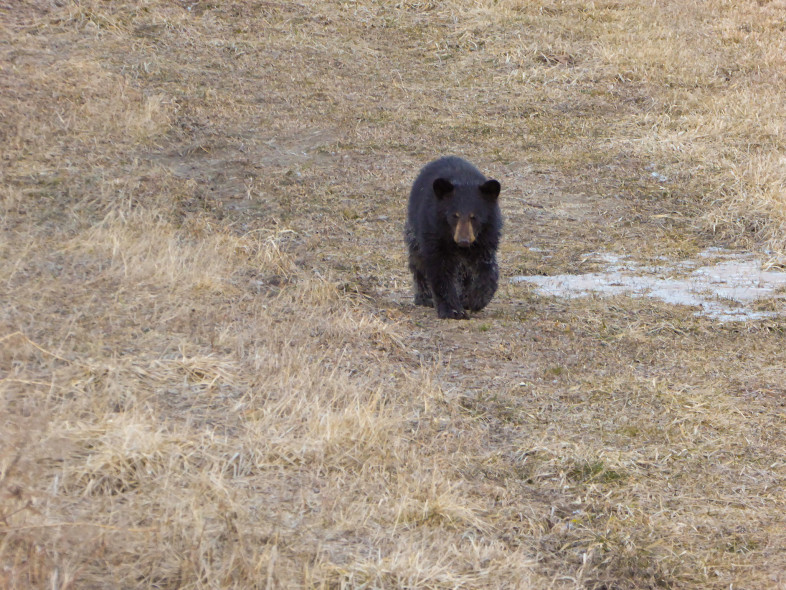
Black Bear observed and reported to iNaturalist Vermont by Kyle Jones.
Black Bear aren’t true hibernators. Sure, their respiration and metabolic rate decrease during winter sleep, but their body temperature remains close to normal. A bear in a winter den can be easily aroused within moments, but an animal that is a true hibernator may take several hours to come to its senses.
For animals that are true hibernators – body temperature, respiration, and metabolic rates are all considerably decreased. Take the Woodchuck as an example. Their heart rate goes from 80 beats a minute when active to just 4 or 5 beats a minute when in hibernation. Their body temperature drops from 98 degrees to a mere 38 degrees Fahrenheit. A Woodchuck’s incisors grow continuously and are kept short through their constant gnawing. But during the winter hibernation, growth stops. True hibernators do wake up every few weeks to nibble on food, and in the case of the Woodchuck, use the underground outhouse.
Food supplies are the most critical factor determining when Black Bears den each the fall. When food is abundant, they’ll continue eating throughout the snows of November and into December. When autumn foods are scarce, most bears den by mid-November.
The den is commonly a brush pile. It may also be a pocket or cave in rocky ledges; a hollow in a large tree or a fallen log; a sheltered depression or cavity dug out at the base of a log, tree, or upturned root; or even a simple hole dug into a hillside. Male bears den up almost anywhere. Females, however, are more particular, selecting protected sites and lining them with stripped bark, leaves, grasses, ferns, or moss.
Good night.
